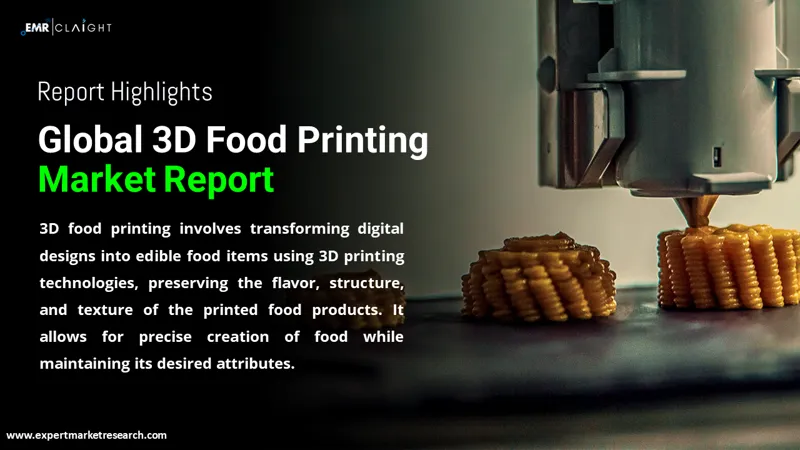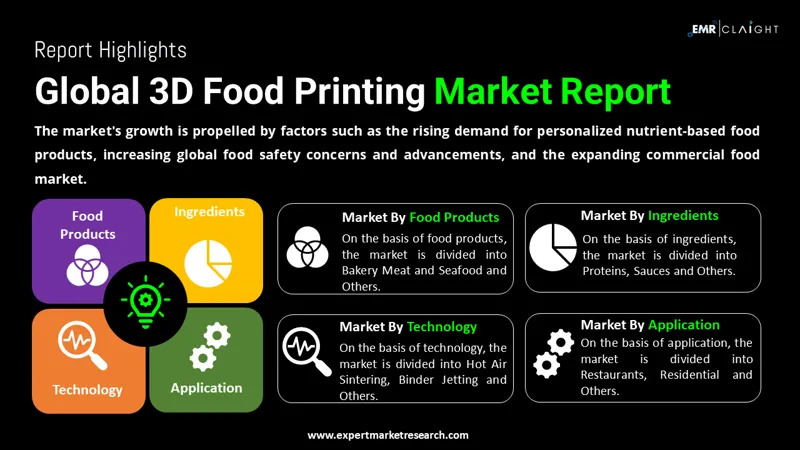
Consumer Insights
Uncover trends and behaviors shaping consumer choices today
Procurement Insights
Optimize your sourcing strategy with key market data
Industry Stats
Stay ahead with the latest trends and market analysis.
The global 3D food printing market size attained a value of approximately USD 729.57 Million in 2025. The market is further expected to grow in the forecast period of 2026-2035 at a CAGR of 58.20% reaching a value of around USD 71636.07 Million by 2035.
Base Year
Historical Period
Forecast Period
Compound Annual Growth Rate
58.2%
Value in USD Million
2026-2035
*this image is indicative*
| Global 3D Food Printing Market Report Summary | Description | Value |
| Base Year | USD Million | 2025 |
| Historical Period | USD Million | 2019-2025 |
| Forecast Period | USD Million | 2026-2035 |
| Market Size 2025 | USD Million | 729.57 |
| Market Size 2035 | USD Million | 71636.07 |
| CAGR 2019-2025 | Percentage | XX% |
| CAGR 2026-2035 | Percentage | 58.20% |
| CAGR 2026-2035 - Market by Region | Asia Pacific | 67.1% |
| CAGR 2026-2035 - Market by Country | India | 69.5% |
| CAGR 2026-2035 - Market by Country | China | 64.3% |
| CAGR 2026-2035 - Market by Food Products | Chocolate and Confectionary | 64.1% |
| CAGR 2026-2035 - Market by Ingredients | Dough | 66.4% |
| Market Share by Country 2025 | Japan | 4.2% |
Food may be customised to meet the unique needs of consumers through 3D food printing. The expansion of the custom food market is a key driver of the 3D food printing market, supported by rising disposable income, increasing nutritional awareness, and growing desire for customised meals. People are frequently preoccupied with their jobs and unable to enjoy their favourite dishes due to a lack of time. The ability to create such food products at home without the use of preservatives is thus provided by 3D food printing technology, thus expanding the 3D food printing market. Three-dimensional consumables printing is becoming more popular among consumers with unique dietary requirements and food allergies. In addition, the market will likely be influenced by the rise in the use of 3D printers in plant-based meat alternatives.

Read more about this report - REQUEST FREE SAMPLE COPY IN PDF
North America is expected to account for the largest share of the global 3D food printing market, while the market in the Asia Pacific region is expected to expand at the highest rate in the forecast period. The presence of major 3D food printing companies in North America is helping to expand the demand in this region. In the United States, the government dedicates considerable funds towards healthcare, enabling it to invest heavily towards the use of this technology in hospital applications. The 3D food printers can be used to produce foods rich in specific nutrients, and cater to aged patients with difficulties in chewing and digestion, helping feed patients easily.
The term 3D food printing refers to the process of turning 3-dimensional digital designs into real-world food products using 3D printing technologies. It enables 3D printing of food products while maintaining the product's flavour, framework and texture. The key benefits of 3D printing include the ability to customise meals according to personal desires and specifications, supplying textures, fresh tastes, and shapes for unique and distinctive dining environments.
Breakup by Food Products
Breakup by Ingredients
Breakup by Technology
Breakup by Application
Breakup by Region

Read more about this report - REQUEST FREE SAMPLE COPY IN PDF
| CAGR 2026-2035 - Market by | Country |
| India | 69.5% |
| China | 64.3% |
| UK | 53.2% |
| USA | 51.9% |
| Germany | 48.0% |
| Canada | XX% |
| France | XX% |
| Italy | XX% |
| Japan | 40.1% |
| Australia | XX% |
| Saudi Arabia | XX% |
| Brazil | XX% |
| Mexico | XX% |
Rising recognition among food innovators of the need to update food processing technology is one of the key trends propelling the 3D food printing market growth. The growing commercial food industry, hiking demand for personalised nutrient-based food items adapted to personal nutritional requirements, and increasing concerns about global food safety and development are the key factors influencing the 3D food printing market. Increasing research and development efforts by major players and new market launches for novel food products would further generate new opportunities for the market in the forecast period.
The report gives a detailed analysis of the following key players in the global 3D food printing market, covering their competitive landscape, capacity, and latest developments like mergers, acquisitions, and investments, expansions of capacity, and plant turnarounds:
The comprehensive EMR report provides an in-depth assessment of the market based on the Porter's five forces model along with giving a SWOT analysis.




*While we strive to always give you current and accurate information, the numbers depicted on the website are indicative and may differ from the actual numbers in the main report. At Expert Market Research, we aim to bring you the latest insights and trends in the market. Using our analyses and forecasts, stakeholders can understand the market dynamics, navigate challenges, and capitalize on opportunities to make data-driven strategic decisions.*
Get in touch with us for a customized solution tailored to your unique requirements and save upto 35%!
In 2025, the global market for 3D food printing attained a value of approximately USD 729.57 Million.
The market is projected to grow at a CAGR of 58.20% between 2026 and 2035.
The market is estimated to witness healthy growth in the forecast period of 2026-2035, to reach USD 71636.07 Million by 2035.
The major drivers of the market include the hiking demand for personalised nutrient-based food items, increasing concerns about global food safety and development, and growing commercial food industry.
The key 3D food printing market trends include new market launches of novel food products, increasing research and development, growing recognition among food innovators of the need to update food processing technology, and expansion of major 3D food printing companies.
The major regions in the market are North America, Latin America, the Middle East and Africa, Europe, and the Asia Pacific.
The various food products in the market for 3D food printing are chocolate and confectionary, bakery, and meat and seafood, among others.
The different ingredients of 3D food printing in the market include dough, fruits and vegetables, proteins, sauces, and carbohydrates, among others.
The significant technologies of 3D food printing in the market include hot air sintering, fused deposition modelling (FDM), and binder jetting, among others.
The major applications 3D food printing in the market are restaurants, residential, bakery stores, and hospitals, among others.
The major players in the market are Natural Machines Iberia, S.L., Systems & Materials Research Corporation, Byflow B.V., Procusini, SavorEat, Imaginarium India Pvt Ltd, Chocola3d, Changxing Shiyin Technology Co., Ltd, WIIBOOX-SA, 3D Food srl, PancakeBot LLC, Dovetailed, Redefine Meat Ltd., and Cocoa Press LLC, among others.
Explore our key highlights of the report and gain a concise overview of key findings, trends, and actionable insights that will empower your strategic decisions.
| REPORT FEATURES | DETAILS |
| Base Year | 2025 |
| Historical Period | 2019-2025 |
| Forecast Period | 2026-2035 |
| Scope of the Report |
Historical and Forecast Trends, Industry Drivers and Constraints, Historical and Forecast Market Analysis by Segment:
|
| Breakup by Food Products |
|
| Breakup by Ingredients |
|
| Breakup by Technology |
|
| Breakup by Application |
|
| Breakup by Region |
|
| Market Dynamics |
|
| Competitive Landscape |
|
| Companies Covered |
|
Datasheet
One User
USD 2,499
USD 2,249
tax inclusive*
Single User License
One User
USD 3,999
USD 3,599
tax inclusive*
Five User License
Five User
USD 4,999
USD 4,249
tax inclusive*
Corporate License
Unlimited Users
USD 5,999
USD 5,099
tax inclusive*
*Please note that the prices mentioned below are starting prices for each bundle type. Kindly contact our team for further details.*
Flash Bundle
Small Business Bundle
Growth Bundle
Enterprise Bundle
*Please note that the prices mentioned below are starting prices for each bundle type. Kindly contact our team for further details.*
Flash Bundle
Number of Reports: 3
20%
tax inclusive*
Small Business Bundle
Number of Reports: 5
25%
tax inclusive*
Growth Bundle
Number of Reports: 8
30%
tax inclusive*
Enterprise Bundle
Number of Reports: 10
35%
tax inclusive*
How To Order

Select License Type
Choose the right license for your needs and access rights.

Click on ‘Buy Now’
Add the report to your cart with one click and proceed to register.

Select Mode of Payment
Choose a payment option for a secure checkout. You will be redirected accordingly.
Gain insights to stay ahead and seize opportunities.

Get insights & trends for a competitive edge.

Track prices with detailed trend reports.

Analyse trade data for supply chain insights.

Leverage cost reports for smart savings

Enhance supply chain with partnerships.

Connect For More Information
Our expert team of analysts will offer full support and resolve any queries regarding the report, before and after the purchase.
Our expert team of analysts will offer full support and resolve any queries regarding the report, before and after the purchase.
We employ meticulous research methods, blending advanced analytics and expert insights to deliver accurate, actionable industry intelligence, staying ahead of competitors.
Our skilled analysts offer unparalleled competitive advantage with detailed insights on current and emerging markets, ensuring your strategic edge.
We offer an in-depth yet simplified presentation of industry insights and analysis to meet your specific requirements effectively.
Share